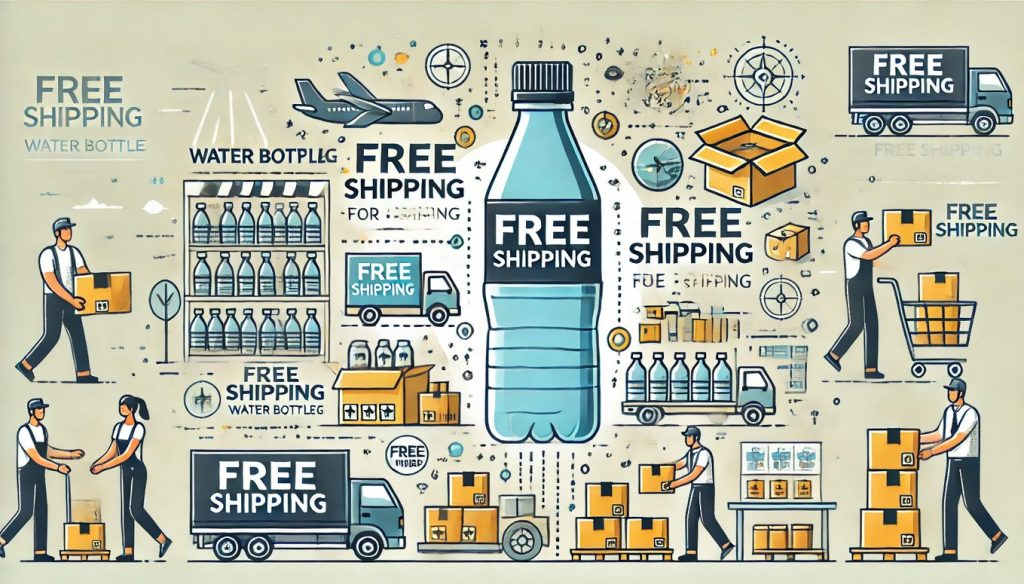The Growing Importance of Free Shipping in E-commerce
In today’s highly competitive e-commerce landscape, offering free shipping has become a major selling point for many businesses. For consumers, the expectation of free shipping has grown substantially, with many shoppers now factoring in shipping costs when deciding where to purchase products. Water bottles, with their relatively low weight and frequent usage, are no exception to this trend.
Offering free shipping may seem like a simple perk, but it involves careful consideration and strategic planning. Especially for water bottle sellers, who may operate on thin profit margins, the decision to offer free shipping requires weighing the potential benefits against the costs. On the one hand, offering free shipping can increase sales, improve customer satisfaction, and help businesses stand out from competitors. On the other hand, it can significantly impact profit margins and necessitate adjustments to pricing strategies or fulfillment processes.
The Benefits of Offering Free Shipping
Increased Conversion Rates and Higher Average Order Value
One of the most compelling reasons to offer free shipping on water bottles is the potential to boost conversion rates. Consumers are often deterred by unexpected shipping costs that appear at checkout. In fact, studies show that over 60% of online shoppers abandon their cart when faced with additional charges like shipping fees. Offering free shipping removes this hurdle, leading to higher conversion rates and, ultimately, more completed sales.
Moreover, free shipping can encourage customers to increase their order size. Knowing they won’t have to pay for shipping costs may motivate customers to add extra items to their cart—such as additional water bottles, bottle accessories, or even customizations. This can lead to a higher average order value (AOV), which helps offset the costs of offering free shipping.
For example, if you’re selling a water bottle for $30, offering free shipping might seem like a loss at first glance. However, by incentivizing customers to buy more bottles or related products, you might generate additional sales that make up for the shipping cost. Bundling products, offering discounts on bulk purchases, or cross-selling related items can all contribute to maximizing the profitability of your free shipping offer.
Enhanced Customer Satisfaction and Loyalty
Offering free shipping can significantly enhance customer satisfaction. In a market where consumers have numerous options for purchasing water bottles, offering this perk makes your brand more attractive. It signals that your business is willing to go the extra mile to deliver value to your customers. In fact, research suggests that 69% of consumers say free shipping is the number one factor that influences their decision to purchase online.
Customers who feel that they are receiving a good deal on shipping are more likely to feel positive about their shopping experience and are more likely to return for repeat purchases. This brand loyalty can result in higher lifetime customer value (CLTV) and better word-of-mouth marketing. Additionally, customers who are satisfied with your service are more likely to leave positive reviews, further enhancing your brand’s reputation.
Competitive Edge in a Crowded Market
With the growing popularity of reusable water bottles, the market has become increasingly saturated. From stainless steel to BPA-free plastic and glass water bottles, there are plenty of options for consumers to choose from. By offering free shipping, your business can gain a competitive edge over others who charge for shipping.
Consumers are likely to compare prices and shipping costs across different stores before making a purchase. If you’re offering free shipping while a competitor charges, even if the difference is minor, it could be the deciding factor for customers. The perception of receiving a better deal often outweighs the actual cost difference, making free shipping a powerful competitive differentiator in the water bottle industry.
The Costs and Considerations of Offering Free Shipping
Impact on Profit Margins
While the advantages of free shipping are clear, it’s important to recognize the financial impact on your business. Shipping is a cost that most businesses must absorb, especially if the company absorbs the entire shipping cost rather than passing it on to the customer. For water bottles, which are generally lightweight but can vary in size and material, shipping costs can fluctuate. Factors such as destination, weight, and the shipping carrier used all play a role in determining how much free shipping will actually cost your business.
If you choose to offer free shipping across all orders, this could result in significant reduced profit margins. For example, if the average cost of shipping a water bottle is $5, but your profit margin on each bottle is only $8, offering free shipping could eat into a large portion of your profits.
To offset these costs, some businesses may raise their product prices slightly to absorb the shipping costs. However, this approach can be tricky. While a slight price increase might seem reasonable, it may also make your products less competitive. Many customers are very price-sensitive, and a higher price could drive them to a competitor who offers lower prices—regardless of the shipping fee.
The Complexity of Shipping Logistics
Implementing a free shipping policy for water bottles requires efficient shipping logistics. Ensuring that your shipping methods are reliable, cost-effective, and fast is key to maintaining a positive customer experience. The complexity of managing shipping for a wide range of products, especially if you sell in multiple regions or countries, can quickly add up.
For example, if you sell eco-friendly water bottles made from glass or stainless steel, the fragility of the product must be considered when determining how to ship it. Some types of water bottles may need more careful packaging, requiring additional resources or heavier packaging, which increases shipping costs.
In addition to product fragility, managing shipping timelines across various carriers is another concern. Delays or mishandling of orders can lead to negative customer experiences, and if free shipping results in slower delivery, it may cause frustration. A balance between offering free shipping and ensuring timely delivery is essential to maintaining a positive customer service experience.
Setting Free Shipping Criteria: Minimum Order Value and Eligibility
To mitigate the financial strain of offering free shipping, many businesses set certain criteria or restrictions on free shipping. One common strategy is to require a minimum order value. By setting a threshold, such as $50 or $75, businesses can ensure that only customers who spend a certain amount qualify for free shipping. This not only helps reduce the number of small orders that would significantly impact profit margins but also encourages customers to purchase more.
Another strategy is to offer free shipping only on specific eligible products. For instance, you may offer free shipping on water bottles, but not on accessories or personalized items that require special handling. By limiting free shipping to select categories, you can control the costs while still delivering value to customers.
Businesses can also restrict free shipping to certain regions or countries. If you offer global shipping, providing free shipping only within a specific region (such as the continental U.S.) allows you to cater to local customers without incurring high international shipping costs.
Alternative Approaches to Free Shipping for Water Bottles
Free Shipping with a Membership or Subscription Program
Rather than offering free shipping across all orders, some businesses opt for membership or subscription programs. In these programs, customers pay an annual or monthly fee in exchange for unlimited free shipping or discounted rates. Amazon Prime is a prime example of this model, which has been widely adopted by many e-commerce businesses.
For water bottle brands, implementing a similar membership program can help mitigate the costs of offering free shipping while fostering brand loyalty. For example, you could offer customers a subscription to receive a water bottle or accessories on a recurring basis, coupled with free shipping on all orders. This would not only cover shipping costs but also increase customer retention and provide a predictable stream of revenue.
Free Shipping as a Limited-Time Offer or Promotion
Instead of providing free shipping year-round, offering it as a limited-time promotion can create a sense of urgency, encouraging customers to take advantage of the offer while it lasts. For example, offering free shipping during a major holiday season or for a specific sales event (e.g., Black Friday, Cyber Monday, or Earth Day) can drive traffic and boost sales without permanently affecting your profit margins.
Seasonal promotions for free shipping can also be paired with other sales tactics, such as discounts on bulk purchases or exclusive deals on new products. By offering free shipping during key sales periods, businesses can increase their volume of orders, helping to balance the shipping costs with higher overall revenue.
Tiered Shipping Models
A tiered shipping model offers free shipping only for orders above a certain dollar amount, but with different tiers based on shipping speed or destination. For example:
- Free Standard Shipping: Customers receive free shipping on orders over a set threshold, but it may take 5-7 business days for delivery.
- Expedited Shipping: Customers who want faster delivery can pay a small fee for expedited shipping.
This tiered model allows customers to choose how much they want to pay for shipping, while still incentivizing higher order values for free shipping. It also allows businesses to maintain profitability while offering value to customers who are willing to wait for longer delivery times.
Measuring the Impact of Free Shipping on Your Water Bottle Business
Tracking Key Performance Indicators (KPIs)
To determine whether offering free shipping is worth it, you should measure its impact on your business through specific Key Performance Indicators (KPIs). These might include:
- Conversion Rate: Monitor whether offering free shipping increases the percentage of visitors who complete a purchase.
- Average Order Value (AOV): Track if free shipping encourages customers to purchase more water bottles or accessories to meet minimum order thresholds.
- Customer Retention Rate: Measure how offering free shipping influences repeat purchases and long-term loyalty.
- Profit Margins: Assess how the costs of offering free shipping affect your overall profitability, including any changes in sales volume or product pricing.
- Customer Satisfaction and Reviews: Keep track of customer feedback to understand how free shipping impacts their experience and perceptions of your brand.
By monitoring these KPIs, you can fine-tune your free shipping policy to maximize its benefits and minimize its drawbacks.
Conclusion
Offering free shipping for water bottles can be an effective strategy for increasing sales, improving customer satisfaction, and gaining a competitive edge. However, it is important to consider the associated costs, including its impact on profit margins, shipping logistics, and overall business sustainability. By exploring alternative strategies such as offering free shipping with a minimum order value, implementing membership programs, or using limited-time promotions, you can find a balance that maximizes the benefits of free shipping without compromising profitability. Ultimately, offering free shipping can be a powerful tool, but it should be strategically implemented to ensure that it is worth the investment.







